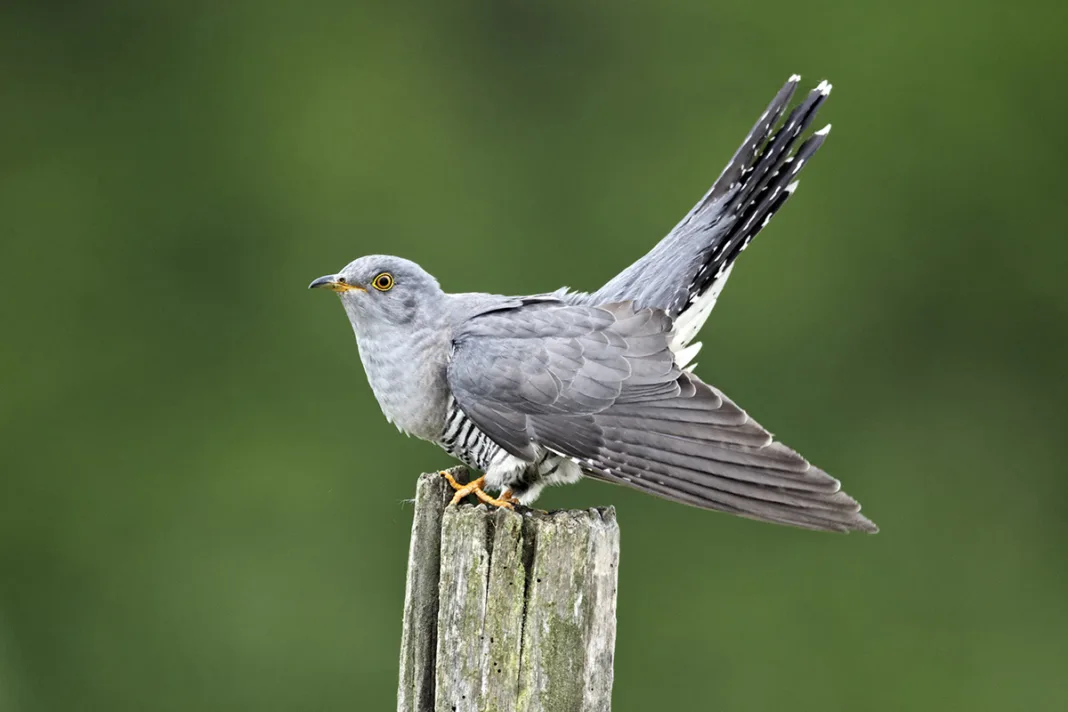Jarrod Cotter turns his attention to the cuckoo, whose characteristic call that once announced the arrival of spring is now rarely heard in the British countryside
THE cuckoo is a dove-sized bird with ash-grey upperparts, head and chest, and dark-barred white underparts. Its sleek body, long tail and pointed wings imitates the sparrowhawk and kestrel. This summer visitor is a well-known brood parasite, with the females laying their eggs in the nests of other birds, especially meadow pipits (Anthus pratensis), dunnocks and reed warblers (Acrocephalus scirpaceus). Their bird-of-prey likeness is said to be used to panic and confuse the host birds.
The cuckoo has had a severe population decline in recent years, making it a Red List species. The British Trust for Ornithology (BTO) coordinates the work of thousands of volunteers who carry out a wide range of studies on the distribution and breeding success of British birds. Data from two of its most important surveys – the Common Birds Census, which ran from 1962-2000, and its successor, the Breeding Bird Survey – have shown a drastic decline in the number of cuckoos in our countryside. By 2014, there were only about a quarter of the number of cuckoos being recorded, compared to population levels in the 1970s and 1980s.
Cuckoos feed on insects, especially hairy caterpillars. A decline in the availability of this food for the adults is among the problems this species faces. Cuckoos are known to favour hairy caterpillars, such as the “Woolly bear”, the caterpillar of the garden tiger moth. Populations of this moth have declined by about 92 per cent since 1968, which is one of the reasons for the cuckoo’s decline. Others include a fall in the numbers of host species, as well as some hosts breeding slightly earlier due to climate change.
This species doesn’t stay long in the UK. Individuals arrive in April to coincide with the host species’ breeding seasons, and are gone by about July. Only the juveniles stay a little longer until August or early September. Their migratory route takes them from the UK across Europe and then through the Mediterranean via Italy, Greece or Sardinia/Corsica. Then there is the dangerous crossing of the Sahara to the birds’ wintering grounds in West Africa.
Over the years for many people, hearing the song of the cuckoo has meant that spring has arrived. So, it is really sad that future generations may not get a chance to become familiar with the cuckoo’s call as being so.
This bird’s tail feathers are black with white tips. There are rows of irregular white spots along the shaft and edges, less so or occasionally absent on the central pair. Spots on the inner webs sometimes form short bars and occasionally join spots to form irregular bands. The flight feathers are dark grey, with the outer primaries being a dull black. The inner webs of the primaries have a row of large white spots, which are largest towards the base and get progressively smaller. Secondaries are ash-grey and have a large white patch at the base of the inner web.
■ Note: No birds have been harmed or distressed in the collecting of any feathers featured in this series and the author has acted in accordance with all the relevant Government licences. Feathers have been collected as naturally moulted examples, from historic taxidermy mounts, or at bird-of-prey kill sites, etc.
Find more news and articles like this on the Cage & Aviary Birds website. Subscribe to Cage & Aviary Birds magazine now.


